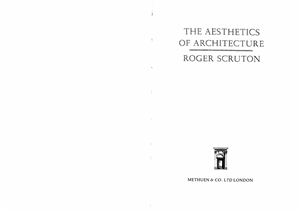Princeton University Press, 1979. - 312 Pages.
Scruton takes his readers on a jouey through aesthetic theory and tries in every sense to apply them directly to architecture. By using theories from Kant, Marx, Freud, Hume, Alberti, Ruskin and many others on topics such as constructivism, and literary theory, Scruton tries to find the essence of architecture. Has architecture an essence?
The book seemed to have many topics that were mentioned but not neccessarily completed which led to (at times) difficult reading and lost thought. The book also was biased in the sense that it praised the past and was unsure of the present and future of architecture.
For those that have an inherent interest in aesthetics, architecture (particulary classical architecture), and classical thinking this is a good book to read.
Scruton takes his readers on a jouey through aesthetic theory and tries in every sense to apply them directly to architecture. By using theories from Kant, Marx, Freud, Hume, Alberti, Ruskin and many others on topics such as constructivism, and literary theory, Scruton tries to find the essence of architecture. Has architecture an essence?
The book seemed to have many topics that were mentioned but not neccessarily completed which led to (at times) difficult reading and lost thought. The book also was biased in the sense that it praised the past and was unsure of the present and future of architecture.
For those that have an inherent interest in aesthetics, architecture (particulary classical architecture), and classical thinking this is a good book to read.

